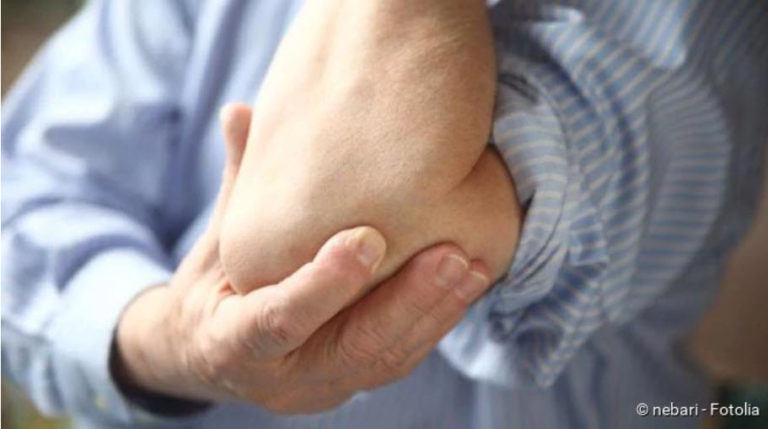Umbilical hernia: symptoms, causes, diagnosis
Umbilical hernia: symptoms, causes, diagnosis

Brief overview
- What is an umbilical hernia? Gap in abdominal connective tissue in the umbilical region
- Symptoms: Swelling or protrusion in the umbilical region; if organs are trapped, pain, possibly blood in the stool, possibly general signs such as fever, nausea, palpitations
- Causes: Combination of weakness of the connective tissue and increased internal pressure in the abdomen; favoured by obesity, pregnancy, heavy lifting, coughing or certain diseases such as dropsy
- Diagnosis: palpation, ultrasound if necessary
- Treatment: Umbilical hernia often heals by itself in children. In adults, surgery is usually necessary.
Umbilical hernia: Description
In the case of umbilical hernia (bellybutton hernia), the navel does not break like a bone would break, even if the name suggests it. Instead, a gap or tear develops in the so-called abdominal wall fascia in the navel area. This is the connective tissue sheath (muscle skin) that stabilizes the abdominal wall. The umbilical hernia belongs to the so-called external hernias. These are “fractures” of the abdominal wall. There are also internal hernias such as the diaphragmatic hernia (diaphragmatic hernia).
Hernial orifice, hernial sac and hernial contents
Behind the navel there is only a thin fascia and some connective tissue. This is a weakness in the abdominal wall that can give way under certain circumstances. The gap that then develops is the so-called hernial orifice. If only the peritoneum – the innermost layer of the abdominal wall – slips through this gap, a small protrusion (bulge) is created. It is called hernial sac and usually causes no discomfort. With increased pressure in the abdominal cavity, however, parts of the abdominal organs (such as an intestinal loop) can also push through the hernial orifice into the protrusion (hernial contents). This can be painful – and if the organs are trapped, even life-threatening!
In an umbilical hernia, abdominal organs protrude outwards through the natural weakness of the abdominal wall
The risk of complications such as entrapment (incarceration) is about 30 percent in adults with umbilical hernia.
Umbilical hernia: treatment
The umbilical hernia therapy depends mainly on the severity of the hernia and the age of the patient. For example, a congenital umbilical hernia in infants is not treated at all: In about 90 percent of cases, it recedes of its own accord in the first years of life.
Sometimes the wearing of an umbilical hernia bandage is recommended. This is a corset-like band to stabilize the abdominal wall. However, this form of umbilical hernia treatment is usually not suitable. This is because the bandage cannot prevent a possible pinching of abdominal organs. It can also cause pressure damage to the skin and weaken the abdominal wall.
An umbilical hernia operation is almost always necessary in adult patients and less frequently in children.
Umbilical hernia Surgery
If the hernial orifice has not yet grown together in children up to pre-school age, surgery is usually performed. Also an umbilical hernia in adults usually requires surgery. Only in the case of very small umbilical hernias that do not cause any discomfort, the doctor can wait and examine the hernial orifice regularly.
If abdominal organs (such as an intestinal loop) are trapped in the hernial orifice (incarceration), surgery must be carried out as quickly as possible – life may be in danger!
Depending on the size of the hernial sac and the patient’s state of health, different surgical methods are possible. In general, the doctor will move the hernia contents back into the abdominal cavity during the operation and possibly remove the hernia sac. In the case of a smaller umbilical hernia, he can then suture the hernial orifice directly. For larger umbilical hernias, on the other hand, he will first sew a plastic net under the abdominal wall to stabilize it.
A hospital stay is not necessary for every umbilical hernia operation. Sometimes it can also be done on an outpatient basis. As a rule, the patient is given a general anaesthetic for the operation. In some cases it is also sufficient to put the patient into a twilight sleep (analgosedation).
You can read everything important about the surgical treatment of umbilical hernias in the article umbilical hernia surgery.
Umbilical hernia: symptoms
One of the most important symptoms of umbilical hernia is a swelling or protrusion in the umbilical region. However, small umbilical hernias are sometimes not visible at all – only under increasing abdominal pressure, for example by coughing, pressing or heavy lifting, does the typical bump develop.
Usually a (small) umbilical hernia does not cause any complaints. This is then a so-called asymptomatic umbilical hernia. If there are complaints against it, it is a symptomatic umbilical hernia.
Incarcerated umbilical hernia: symptoms
If the protrusion becomes larger in the umbilical region, this may be due to parts of the abdominal organs (like an intestinal loop) having pushed themselves into the umbilical hernia cleft. Sometimes the contents of the hernial sac can be pushed back into the abdominal cavity (reduction). If not, the diagnosis is a non-reducible umbilical hernia. The contents of the hernia sac are jammed (incarcerated hernia). Sudden severe pain and a pressure-sensitive abdominal wall (peritonism) are then added as symptoms of umbilical hernia. The pain usually occurs in the area of the navel hernia and can be long-lasting and colicky. They are often associated with nausea and/or vomiting. Fever, palpitations and sweating are also possible. Stool retention may occur. Sometimes the skin over the umbilical hernia is also reddened.
Sudden severe abdominal pain with a very tense abdominal wall, often accompanied by nausea and/or vomiting, is known as an “acute abdomen”. This is an emergency that must be treated quickly – life may be in danger!
Umbilical hernia: causes
Doctors distinguish between congenital and acquired navel fractures:
Congenital umbilical hernia
During embryonic development, a natural (physiological) umbilical hernia is “standard”: the body of the embryo is still too small at this stage to accommodate the rapidly growing small intestinal loops. However, this condition is temporary and usually disappears on its own during further embryonic development: The children are born with an umbilical hernia. This congenital umbilical hernia is the most common form of umbilical hernia with 98 percent.
Acquired umbilical hernia
The abdominal wall of the human being has weak points which favour an abdominal wall hernia. This applies to both infants and adults. A typical weak spot is the navel. This is because the umbilical cord has attached there in the womb. The navel is therefore more or less a scar that is only thinly backed by a muscular skin – and this is susceptible to fracture(s).
At this weak point of the connective tissue of the abdominal wall, a gap can develop in the abdominal cavity when the internal pressure is increased – an umbilical hernia develops. The increase in pressure in the abdominal cavity can have the following causes, for example:
- Overweight
- Pregnancy
- Cough
- Lifting heavy loads
- Abdominal dropsy (ascites)
Most often the acquired umbilical hernia affects premature babies who suffer from lung infections and often cough or cry. This places a particularly heavy load on the abdominal wall. The increased pressure in the abdominal cavity causes an umbilical hernia.
Adults often get an umbilical hernia if the umbilicus is stretched over a longer period of time. Women between the ages of 40 and 50, who often have several pregnancies behind them and/or have weak connective tissue, are therefore particularly frequently affected. Other risk factors for an umbilical hernia in adults are overweight, severe weight loss, ascites and intense physical activity. Smoking also has a negative influence: it impairs the collagen metabolism and thus the stability of the connective tissue. This favors an umbilical hernia.
Pregnancy is another risk factor: the pressure of the growing child in the abdomen and the internal organs can cause an umbilical hernia. A small umbilical hernia usually causes no discomfort and is usually harmless. Usually it disappears again after birth and does not need treatment. Recovery gymnastics can also help, as they strengthen the muscles. If the gap does not close and an operation is necessary, it should not be performed until several weeks after birth.
Umbilical hernia in the baby
Umbilical hernia is quite common in babies and usually harmless. It generally heals on its own: the umbilical ring – the point where the umbilical cord passes through the womb – usually scars after birth. However, this does not happen in about a fifth of all babies – the gap in the navel area remains.
Although umbilical hernia is common and usually harmless in babies, parents should take their child to a pediatrician. If the umbilical hernia does not cause any complaints, the doctor will first push it back again. If the ring musculature becomes stronger, the umbilical hernia will regress by itself over time. However, if the umbilical hernia has a diameter of more than one centimetre or if the child has complaints, surgery may be necessary.
Learn more about umbilical hernia in babies in the article Umbilical hernia – Baby.
Umbilical hernia: examinations and diagnosis
In order to diagnose an umbilical hernia, the doctor examines the patient preferably in a supine position. He can usually feel the protrusion and the fracture opening well. In 95 percent of the cases the umbilical hernia is well visible from the outside. In addition, the doctor will try to push (reduce) the hernia sac back into the abdominal cavity. This is usually possible without any problems. If not (non repositionable umbilical hernia), this can be an alarm signal that abdominal organs have become protruding and may be life-threateningly clamped. The doctor can determine whether there is actually an incarceration by means of an ultrasound examination.
Differentiation from other diseases
A protrusion in the umbilical region does not always have to be an umbilical hernia. Sometimes it is a lipoma. It’s a benign fat tumor. Alleged symptoms of umbilical hernia such as abdominal pain can also turn out to be signs of another disease, for example inflammatory bowel diseases such as enterocolitis (irritable bowel syndrome – irritable colon) or intestinal obstruction (ileus). Sometimes there is also a different form of hernia than umbilical hernia behind it. This can be an epigastric hernia (abdominal wall hernia between navel and sternum) or a paraumbilical hernia. The latter is a hernia next to the navel.
Umbilical hernia: Prevention
Anything that weakens the umbilical region can increase the risk of a hernia. As a preventative measure, one should avoid overweight or years of hard physical work. When lifting heavy loads, you should take care not to put too much strain on the abdominal wall. Through specific exercises you can additionally strengthen the abdominal and trunk muscles and thus reduce the risk of an umbilical hernia.





